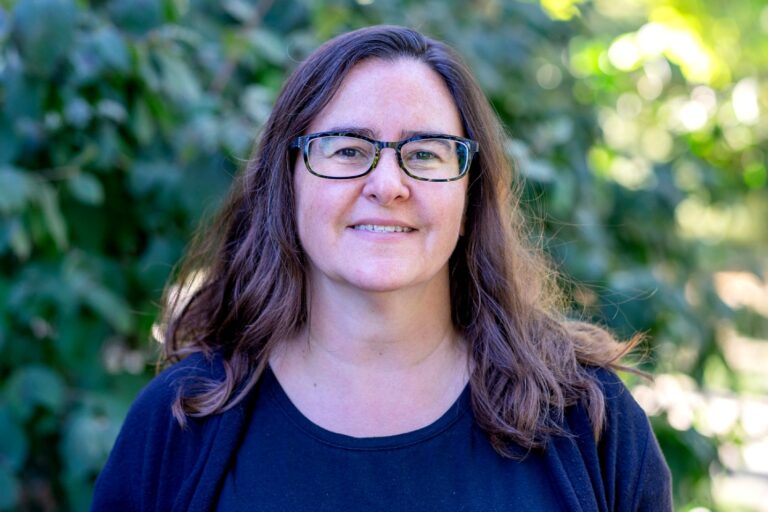Last year, at the start of Black History Month, College of Arts & Letters alumna Asmaa Walton began posting covers of art monographs, exhibition catalogues, and art biographies of African American visual artists to Instagram. An Art Education graduate, Walton was in the middle of her appointment as the Romare Bearden Graduate Museum Fellow at the Saint Louis Art Museum and wanted to share the rare and often hard-to-find works she had found with a wider audience.
Now a year later, Black Art Library is the focus of an exhibition at the Museum of Contemporary Art Detroit (MOCAD), opening February 5 and on view through April 18. The exhibition showcases Walton’s collection of nearly 400 books, research materials, and ephemera on Black visual art and artists.

(Photo by MSU alumna Sarah Fleming)
“I’m doing the work of compiling everything and making this huge resource that anyone can experience,” Walton said. “People who are interested in these materials won’t have to do all of the work that I did to find out about these artists, some of whom I didn’t even know existed until I searched on the Internet and all of these other places. I want to put all the information and the resources in one place so people can easily find it without all the guesswork. Because if you don’t know what you’re looking for, it’s really hard to find it.”
The MOCAD exhibition is the most recent in a series of fortuitous events that began when Walton, who moved back to her native Detroit last July, met artist Tony Rave. Rave offered the use of his artists’ space in Highland Park for Black Art Library’s first pop-up in September 2020. Through that pop-up, Walton met Jova Lynne, MOCAD’s newly appointed Susanne Feld Hilberry Senior Curator. By October, plans were in the works for the more expansive exhibition, where audiences can read and engage with Black Art Library materials.
I’m doing the work of compiling everything and making this huge resource that anyone can experience. People who are interested in these materials won’t have to do all of the work that I did to find out about these artists, some of whom I didn’t even know existed until I searched on the Internet and all of these other places.
The exhibit is unique not only for its emphasis on generations of cultural production by and about Black visual arts and artists but also because museum audiences will be able to read, and touch, the rare materials. Walton emphasizes that the tactile nature of books is a large part of why she wanted Black Art Library to exist.
“People often buy books, look at them once, and then they just sit on the bookshelf for a really long time,” she said. “I think just being able to see them is not the same. You don’t get to engage in the same way because you don’t have access to the knowledge inside the book — you’re more focused on the book as an object rather than as a source of information about a particular subject. I want people to be able to learn from them.”

Walton notes that, as the library expands, conservation will become important because of the fragile state of many of the materials. While she remains mindful of each book’s condition, keeping them from others would defeat the purpose. For now, public access is key, and it’s something she doesn’t take for granted. Walton’s mother works for the Detroit Institute of Arts (DIA), so her childhood was filled with art. As a student in the Detroit Public School system, however, it was an experience she knew was not shared by her peers, as arts programs in DPS had dwindled or disappeared altogether.
And, while she doesn’t think that access is the only obstacle to a better public understanding of Black art, she does think it’s a significant one.
“I spent a lot of time at [my mother’s] desk playing computer games because I was a child, and that was way more interesting to me,” Walton recalled, laughing. “But I was always in the museum. She always had books around and posters from exhibitions. We would take them home and put them on the wall. So, the visual arts were always around me. And that is not the case for everyone in Detroit. After, maybe, first grade, I didn’t have visual arts classes anymore. Detroit Public Schools have performing arts and dance at some of the schools. They have orchestras. But there was no painting, no ceramics, no drawing.”

The lack of visual arts curriculums in her hometown’s public schools factored into Walton’s decision not to pursue a teaching certificate immediately after completing her bachelor’s degree in Art Education, opting instead to pursue an MA in Art Politics at New York University’s Tisch School of the Arts (NYU).
“I didn’t want to teach in a traditional classroom setting because I knew I wasn’t going to be able to reach the students that I wanted to be teaching,” Walton said. “I thought, ‘I’m not going to be able to teach at a public school. I’m not going to be able to do the work that I really want to do.’”
While at NYU, she soon realized that she could apply her education to work in museums. After graduate school, she served as Education and Engagement Intern at the Toledo Museum of Art and was subsequently appointed the museum’s first KeyBank Fellow in Diversity Leadership, followed by her fellowship at Saint Louis Museum of Art — a series of roles that made her even more passionate about finding alternative ways to reach a public that may not typically visit museums.

Since founding Black Art Library, Walton has received books and artifacts from donors, as well as funds for purchases through her GoFundMe page. Initially, she paid for everything herself. Recent finds and gifts include a VHS tape of Faith Ringgold’s Tar Beach, hundreds of 35-mm slides of works by Black visual artists, and a T-shirt from conceptual artist William Pope.L’s infamous The Black Factory.
Her goal within the next two years is to open a brick-and-mortar location and create public programming and resources for researchers.
I want people to know what Black Art Library is before it has its own space. So that means I have to go out into the community into different spaces and show the project and really make sure that I’m engaging. I really want it to be a community thing.
“I definitely want to find the books a permanent home, but pop-ups and the MOCAD exhibit give me the chance to give the idea of the library exposure,” she said. “I want people to know what Black Art Library is before it has its own space. So that means I have to go out into the community into different spaces and show the project and really make sure that I’m engaging. I really want it to be a community thing.”
As part of the opening of the Black Art Library exhibit, MOCAD is hosting a virtual discussion and Q&A with Walton on Friday, February 5, at 4 p.m. where she will talk about creating access to Black art and Black art history as a means of deepening our capacity to imagine Black futures. For more information on this talk or the Black Art Library exhibit, visit the MOCAD website.


